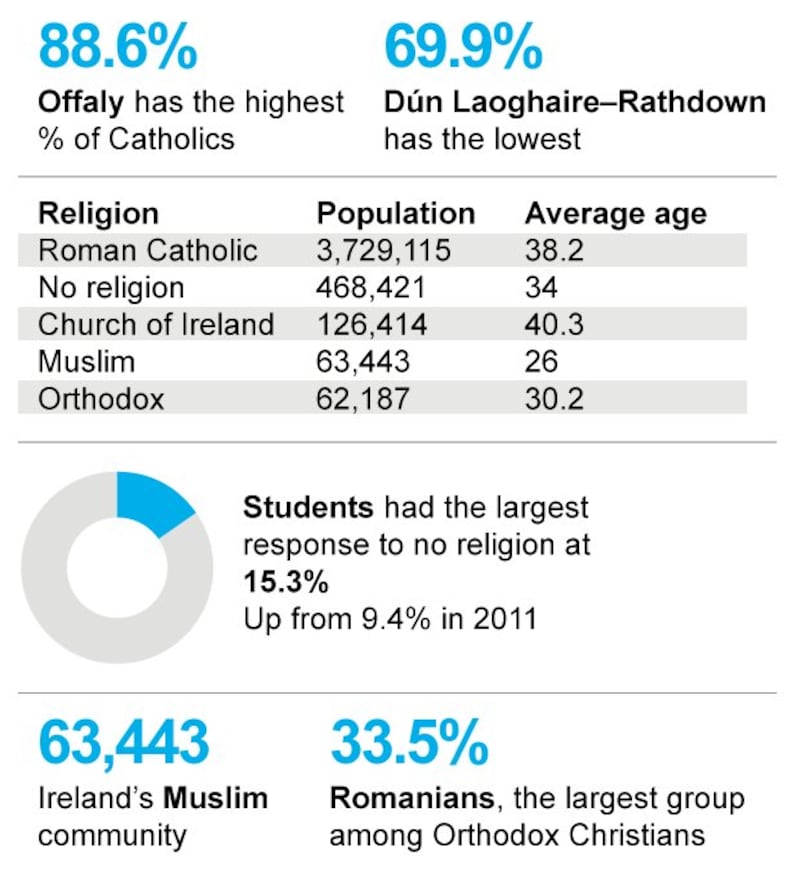Offaly is the most Catholic county in Ireland while Dún Laoghaire-Rathdown is the least Catholic, according to new Census data published by the Central Statistics Office on Thursday.
Longford has the smallest number of people who ticked "no religion" on census form in April 2016 while Co Cork has more members of the Church of Ireland than anywhere else in the State, according to the data.
In Offaly 88.6 per cent of the population identifies as Catholic, while in Dún Laoghaire-Rathdown that figure is 69.8 per cent.
Catholics have the lowest divorce rate at 4.1 per cent, compared to a national average of 4.7 per cent, a figure which has gone up from the average of 3.6 per cent in 2011.

The number of Jewish people is up 28.5 per cent to 2,557, an increase of 573 in five years.
Most Muslims live in Dublin city and county and, on average, are the youngest religious grouping in the State. Members of the Church of Ireland are the oldest on average, while Orthodox Christians are among the fastest growing grouping and are almost on a par with Muslims in number.
Persons born outside of Ireland comprised 12.0 per cent,or almost one in eight of the State’s total Catholic population in 2016.
These are some of the latest details from the April 2016 census which are published by the Central Statistics Office today.
It reports how both the proportion and total number of Catholics has fallen since the last census in 2011, with Catholics comprising 78.3 per cent of the population in April 2016, down from 84.2 per cent in 2011.
The number of people with no religion (including atheists and agnostics) increased by 73.6 per cent to 481,388 in 2016. One of the fastest growing sectors in the population are those who say they have no religion with an increase of 204,151 on the 2011 census figures.
They are now the second largest category category in the State making up 10.1 per cent of the population, up from 6 per cent in 2011. With an average age of 34 years, such people are on average also 3.4 younger than the population overall.
In general Church of Ireland numbers are down 2.0 per cent since 2011, to 126,414 members in April 2016. With an average age of 40.3 years they are almost three years older on average than the rest of the population.
With 11,551 Church of Ireland members, Co Cork had the the highest number of any county in the State, amounting to 9.1 per cent of all members. Dublin city is next with 11,149 people (8.8 per cent), while Leitrim had the lowest number of Church of Ireland members at 1,102 people (0.9 per cent).
There were 63,443 Muslims in Ireland in April 2016, up from 49,204 (28.9 per cent) since 2011.
With an average of 26 these are also among the youngest of our population when religious affiliation is examined, with 16,364 (25.8 per cent) aged between 5 and 18 years old. Most Muslims in Ireland, 43.5 per cent, live in Dublin city and suburbs.
In April 2016, there were 62,187 Orthodox Christians in Ireland, up 37.5 per cent on 2011. However the number of Presbyterians, at 24,211, has fallen slightly to 24,600, from 2011.
Among the smaller Christian groupings the Apostolic and Pentecostal population rose from 3,152 people in 2002 to 13,350 in 2016, an annualised growth rate of over 10.9 per cent.
In 2016 there were also 9,724 Evangelical Christians and 6,471 Methodists, 6,417 Jehovah’s Witnesses, 5,329 Lutherans, and 3,957 Baptists. A further 37,427 identified themselves as ‘Christian’, while 5,409 persons stated that they were ‘Protestant’.
Increases in other religions between 2011 and 2016 were dramatic but from a much smaller base. The 14,332 Hindus recorded in April last year was a 135.6 per cent increase on the number 10 years earlier in 2006 while Buddhists numbers rose by 12.1 per cent, to 9,758, since 2011.





